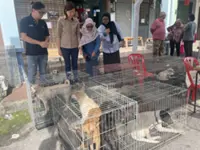Chicks of the critically endangered Brazilian merganser swim on a pond at the zoo in Prague. — Photos: MILAN KAMMERMAYER/AFP
Five chicks of the critically endangered Brazilian merganser have been born at the Prague Zoo, fuelling hopes for a reintroduction of the duck in the wild, a breeder said.
The two males and three females born on Jan 29 are the first Brazilian mergansers ever born outside South America, Prague zoo birds curator Antonin Vaidl said.





